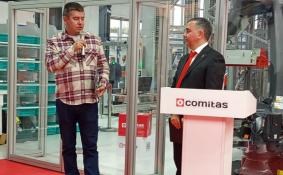Scientific & Practical Journal


Editorial News
We are pleased to present to you the final issue of the journal in 2025 and inform you that LOGISTICS is opening a new page in its development by starting cooperation with the Crystal Growth Foundation, which means that the information saturation of the publication will change for the better. The first issue is dedicated to one of the innovative domestic developments, AI-Kantorovich, which the Crystal Growth Foundation created together with Hive Mind AI.
Dear readers! We are pleased to present to you the eleventh issue of the journal in 2025. There are a lot of relevant and useful materials in the issue, which, hopefully, will not be ignored.
Dear readers! In September the CeMAT RUSSIA exhibition was held, which showed everyone that innovations and robotics are increasingly penetrating the logistics industry. We can safely say that many technologies are tested here, and only then they go out into the world. However, it is not only CeMAT RUSSIA that demonstrates the prevalence of the digital agenda.
PHOTO OF THE WEEK
CITATIONS
Heading:WAREHOUSE. INVENTORY MANAGEMENT
“Familia” in the world of off-price format
Interview with Maxim Aleksandrovich Bulychev, the operating officer of the chain of "Familia" stores8 / 2017 | WAREHOUSE. INVENTORY MANAGEMENT
The history of the OSR ShuttleTM formation
8 / 2017 | WAREHOUSE. INVENTORY MANAGEMENT Migros Zürich orders again FAST Picking solution by the KNAPP company
7 / 2017 | WAREHOUSE. INVENTORY MANAGEMENT Modern warehouse management through three-dimensional interactive visualization
Oleg Finoshin6 / 2017 | WAREHOUSE. INVENTORY MANAGEMENT
Evaluation of the effectiveness of warehousing systems and materials handling through the use of conventional units of selection
Maxim Komissarov6 / 2017 | WAREHOUSE. INVENTORY MANAGEMENT
Traditionally, the assessment of the operational effectiveness of picking operations is based on the rows picked calculation. However, this method does not allow comparing the performance of picking in different storage areas and different warehouses. This problem can be solved using conventional units of selection.
Key words. Logistics, warehouse, assessment of picking effectiveness.
What are the intralogistics gadgets?
Sergey Gnezdilov6 / 2017 | WAREHOUSE. INVENTORY MANAGEMENT
Here information about in-storehouse devices is systematized in the form of classification. For them a new term – “intralogistics gadgets” is suggested.
Key words. Intralogistics, storehouse technologies, storehouse equipment, classification of technologies.
123













